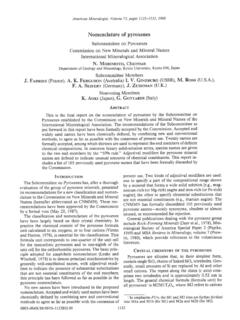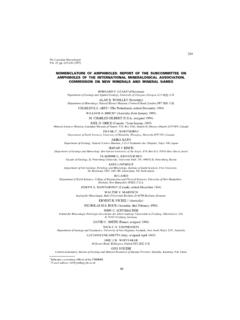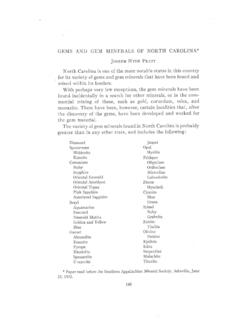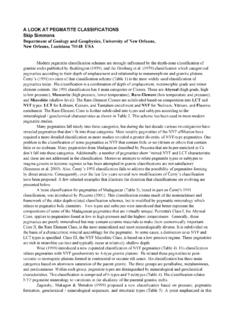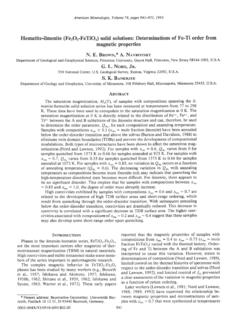Transcription of Thermogravimetric study of the dehydration kinetics of talc
1 American Mineralogist, Volume 79, pages 692-699, 1994. Thermogravimetric study of the dehydration kinetics of talc KuNll- Bosn,* c. G, Department of Geosciences,the University of Arizona, Tucson, Arizona 85721, AssrRAcr The dehydration kinetics of nearly pure talc, (MgorrFeoo,).Si4oro(OH)r, and of pure synthetic talc to enstatite and SiO, was studied as a function of temperature between 777. and 917 oC and of grain size by thermogravimetry the grain-sizerange of I 5- I pm, the rate of dehydration of talc increasedwith decreasinggrain size, but further decreaseofgrain size did not significantly affect the dehydration rate. This may be caused by (l) clustering ofthe fine-grainedparticles as a result ofsurface charging,(2) a tradeoff between the positive effect of larger surface area and the negative effect of nucleating a larger number of product phases,or (3) both.
2 The kinetic data can be adequatelymodeled by a second-orderphenomenologicalrate law. The rate constant (ft) for the size fraction of 10-15 pm of the natural talc follows an Arrhenian relation, k: x l}toexp(-Q/. RQ/min, wherethe activation energyQ: 372 + 7 (o) kJ/mol. Comparedwith talc of the samegrain size,the synthetic talc was found to have a significantly faster dehydration rate. TEM images showedtopotactic growth of enstatite on talc, with a concomitant formation of tridymite. INrnooucrroN der Greenwood's conditions, the decomposition of talc The thermal decomposition of talc has received con- proceeded by means of an intermediate step involving + an- siderableattention over the past 30 years,primarily from the formation of anthophyllite according to talc thophyllite + quartz + HrO + enstatite + quartz +.)
3 The ceramic industry, since talc is used in a variety of industrial and consumer applications. In the context of HrO. Greenwood found that his experimental data can planetary scienceand missions, experimental data on the be adequately modeled by assuming that each step fol- reaction kinetics of talc and other phyllosilicates over a lows a first-order rate law. wide range of pressureare important for the quantitative The work of Bo5kovi6 et al. (1968) is unconvincing analysis of the time-scale of formation of these minerals since, as emphasizedby Ward (1975),they recordedonly within the solarnebula (Fegleyand Prinn, 1988)and oth- one or two points for a given temperature and made no er planetary environments, the depth and rate of release attempt to distinguish betweenabsorbedand structurally of HrO into the mantle wedge during subduction pro- bound HrO.
4 Ward (1975) studied the kinetics of dehy- cesses( ,Delany and Helgeson,1978; Peacock,1990; dration ofwhat he called pure-gradetalc between827 and Boseand Ganguly, 1993),and the evaluationof the fea- 887 "C at I bar, but he provided no chemical analysisfor sibility of the extraction of HrO from asteroidaland Mar- it. Assuming that talc breaksdown to enstatiteand quartz tian rocks for use as fuel and life support for long-range (+ vapor), which is the stablereaction at I bar, he treated planetarymissions(Lewis and Lewis, 1987;Gangulyand the experimental data in terms of first-order reaction ki- Saxena,1989). netics, but it is not clear how well a first-order rate law There have been very few data so far on the dehydra- fitted the experimental data. Further, when the loga- tion kinetics of talc, the major emphasisof earlier works rithms of rate constants given by Ward are plotted vs.
5 Being on the structural changesassociatedwith heating inverse temperature (Fig. l), a sudden break in slope at 'C. talc to high temperatures( ,Nakahira and Kato, 1964; around 875 is indicatesthat either there Bo5kovi6et 1968:Brett et 1970:Daw et 1972'. is a changein the dehydration mechanism above 875 "C. Konishi and Akai, l99l). Bo5kovi6et al. (1968)and Ward or the first-order rate law is invalid over the studied tem- (1975) have carried out Thermogravimetric studies of the not statedby Ward (1975),his dehydration kinetics of talc at I bar, whereasGreenwood experimental activation enthalpy (or energy) fitted only (1963) has studied the kinetics ofdehydration oftalc at the data between826 and 872 "C. The five data at 881- justification. an HrO pressureof I kbar in hydrothermal 886 "C were evidently rejected without any We have reinvestigatedthe dehydration kinetics of talc at I bar with the primary objective of testing the validity * Presentaddress: andGeophysical of Ward's data and determining the reaction mechanism.
6 Departmentof Geological Sciences, PrincetonUniversity,Princeton,New Jersey08544, In addition, we have studied the behavior ofboth natural and synthetic talc, made a preliminary assessmentof the 0003-004 692. BOSE AND GANGULY: dehydration kinetics OF TALC 693. r/oa\. I. c E CounlerW ight Quat Glass Tube 6 feel AI Sample Eurotherm Furnace aaa' (1975). Fig. 2. Schematicillustration of the thermogravimetryappa- Fig. I . Arrhenius plot of the dehydration rate constant (k) of ratusbuilt and usedfor the major portionof the presentwork. talc in the temperaturerange 827-877 t at I bar, as determined Thethermocouple (ft-Ptl00/oRh)passesthroughanexteriorqua rtz- by Ward (1975).The clusterof five data points between881 and glasstube,whichis sealedto the onecontainingthe sample. 887 qC seemsto have been ignored by Ward in rhe derivation of the kinetic parameters.
7 Synthetic talc. Talc was synthesizedhydrothermally at 2 kbar and 640'C from stoichiometricmixtures of MgO. effect ofgrain size on the dehydration kinetics , and tried ( Matthey Puratronic grade) and syn- to develop a general understanding ofthe kinetics ofther- thetic cristobalite, which were sealedwith excessHrO in mal decomposition of the phyllosilicates. Au in. in duration of the syn- thesis experimentsvaried from 2 to 4 d, and eachcapsule Expnnrurrvrul, sruDY. containedabout I 50-200 mg of the mixture of MgO and Starting rnaterials cristobalite. Within the limit of resolution of X-ray dif- Natural talc. The natural talc used in this study came fractometer scans and the optical microscope, the syn- from Gouverneur, New York. Electron microprobe anal- thesisproductswere single-phasetalc. However, the XRD.
8 Ysis of the sample showed it to be essentiallya Mg end- peaks of the synthetic talc were somewhat broader than m e m b e r , w i t h t h e c h e m i c a l f o r m u l a ( M g o n r F e o o , ) . - those ofthe coarse-grainednatural talc. Grain sizesofthe SioO,.(OH), (the analyzedoxide weight percentsare SiO, synthetic talc varied between I and 2 : 6 2 . 8 9 , A l , O r : 0 . 0 1 9 ,M g O : 3 1 . 1 5a, n dF e O : 1 . 0 1 2 ) . The dehydration kinetics of talc was determined at I. F, Cl, Ca, Ni, K, and Ti were below detection levels. A bar by Thermogravimetric experiments, which involved block of this material was cored by a diamond coring tool monitoring the in-situ weight changeof a sampleof known to obtain powders. This method was preferred over the initial weight as a function of temperature and time.
9 The more conventional crushing and grinding, since it mini- majority of the experiments were performed in a ther- mized the sample strain that could affect the dehydration mogravimetric apparatus (TGA) built in-house (Fig. 2). kinetics . A batch of sample with a grain size of l0- I 5 prm For reasonsdescribedbelow, a limited number of exper- was separatedby the centrifuge procedure described be- iments were conducted in a microanalytical TGA at low. It was, however, necessaryto grind this size fraction Princeton University. For experimentsusing the in-house to obtain smallergrain sizes. apparatus, approximately I g of the talc with a size of Three grain-sizefractions, 10-15, l-2, and <l prl, l0-15 pm was placedin an alumina crucible,which was were separatedfrom the powdered material following the suspendedby a Pt wire from the base ofa digital Sauter procedureof Starkeyet al.
10 (1984).The powder was son- analytical balance. The crucible assembly was enclosed ified in distilled HrO before spinning the suspensionin by a quartz-glasstube with a PtlPt l0o/oRh thermocouple an ultra centrifuge (IEC B-22M Programmable Centri- immediately adjacent to, but not touching, the crucible. fuge) at revolution rates and durations specified by In order to ensurethat the talc sample was free of hygro- Stokes'slaw of settling velocity for platy minerals, as de- scopic moisture, a small auxiliary furnace, which was rived by Hathaway ( I 956). Then the supernatantwas de- maintained at a temperature of -130 "C, was placed canted, and the procedure was repeateduntil a sufficient around the quartz tube, and the weight loss of the sample quantity of the desiredsize fraction was obtained. Optical was monitored until the weight becameconstant.
